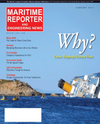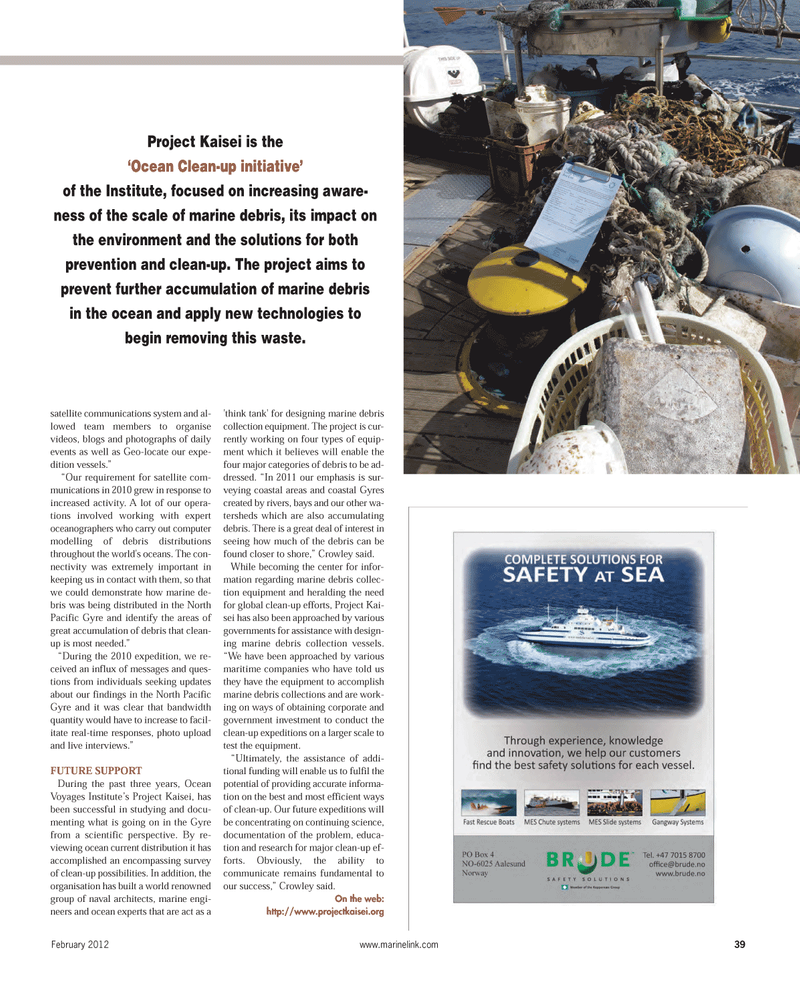
Page 39: of Maritime Reporter Magazine (February 2012)
Cruise Shipping Annual
Read this page in Pdf, Flash or Html5 edition of February 2012 Maritime Reporter Magazine
satellite communications system and al-lowed team members to organise videos, blogs and photographs of dailyevents as well as Geo-locate our expe- dition vessels.? ?Our requirement for satellite com-munications in 2010 grew in response to increased activity. A lot of our opera- tions involved working with expert oceanographers who carry out computermodelling of debris distributions throughout the world's oceans. The con- nectivity was extremely important in keeping us in contact with them, so that we could demonstrate how marine de- bris was being distributed in the North Pacific Gyre and identify the areas of great accumulation of debris that clean-up is most needed.? ?During the 2010 expedition, we re- ceived an influx of messages and ques- tions from individuals seeking updates about our findings in the North Pacific Gyre and it was clear that bandwidth quantity would have to increase to facil- itate real-time responses, photo uploadand live interviews.? FUTURE SUPPORT During the past three years, OceanVoyages Institute?s Project Kaisei, has been successful in studying and docu-menting what is going on in the Gyrefrom a scientific perspective. By re- viewing ocean current distribution it has accomplished an encompassing survey of clean-up possibilities. In addition, theorganisation has built a world renowned group of naval architects, marine engi- neers and ocean experts that are act as a 'think tank' for designing marine debriscollection equipment. The project is cur- rently working on four types of equip- ment which it believes will enable the four major categories of debris to be ad- dressed. ?In 2011 our emphasis is sur- veying coastal areas and coastal Gyres created by rivers, bays and our other wa- tersheds which are also accumulatingdebris. There is a great deal of interest in seeing how much of the debris can be found closer to shore,? Crowley said. While becoming the center for infor- mation regarding marine debris collec- tion equipment and heralding the needfor global clean-up efforts, Project Kai- sei has also been approached by various governments for assistance with design- ing marine debris collection vessels. ?We have been approached by various maritime companies who have told us they have the equipment to accomplish marine debris collections and are work- ing on ways of obtaining corporate and government investment to conduct the clean-up expeditions on a larger scale to test the equipment. ?Ultimately, the assistance of addi- tional funding will enable us to fulfil the potential of providing accurate informa- tion on the best and most efficient ways of clean-up. Our future expeditions will be concentrating on continuing science,documentation of the problem, educa-tion and research for major clean-up ef-forts. Obviously, the ability to communicate remains fundamental toour success,? Crowley said. On the web: http://www.projectkaisei.org February 2012www.marinelink.com 39Project Kaisei is the ?Ocean Clean-up initiative? of the Institute, focused on increasing aware- ness of the scale of marine debris, its impact onthe environment and the solutions for both prevention and clean-up. The project aims to prevent further accumulation of marine debris in the ocean and apply new technologies tobegin removing this waste. MR Feb.12 # 5 (34-41):MR Template 2/7/2012 10:40 AM Page 39

 38
38

 40
40
